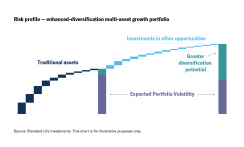To solve for growth while limiting volatility and downside in their portfolios, institutional investors sometimes unknowingly paint themselves into a corner when it comes to allocating risk. This may not be readily apparent, as investors can choose from plenty of options that feel as if they achieve the desired balance. But many of the “go-to” strategies of the moment aren’t conceived or built to minimize risk creep, or conversely, flexible enough to allow additional risk allocation when it might be advantageous.
A strategy that embraces enhanced diversification positions, however, and takes an innovative approach to actively managing risk, could provide investors an opportunity to achieve the best of both worlds – the potential to capture the growth associated with riskier assets without all the drawdown properties, resulting in strong risk-adjusted performance.
Avoiding rigid confines
In a period of modest global economic growth, historically low yields, and high equity levels – a collection of traits not uncommon in recent years – investors are increasingly looking for growth opportunities alongside limited downside volatility in their portfolios. For example, they might consider a factor-oriented, low-volatility equity strategy. By its very construct, however, the rigid and narrow focus of such a strategy leaves it vulnerable to:
- Material underperformance in certain market conditions. Rising valuations of lower volatility equity market segments in recent years leave many low volatility portfolios vulnerable to weaker returns in value-led market rallies.
- Crowding. Similar portfolio construction tools are used to create many of these strategies, resulting in common exposures to risk factors (such as sectors) which can lead to adverse outcomes if a significant portion of the crowd looks to exit or reduce investment at the same time.
- Interest rate sensitivities. Falling rate environments have been positive for these strategies – the reverse might be true in an environment of rising rates.
Investing, of course, is a breeding ground for innovation, and Conlon and his colleague Stuart Peskin, CFA, Investment Director and Multi-Asset Investment Specialist, are part of a wider team that has developed enhanced diversification strategies that can accurately be described as next generation investing. The approach combines an actively managed growth portfolio with a set of diversifying, positive return positions that are tailored to work together with the growth portfolio to improve the overall portfolio’s return and risk characteristics.
Anticipating change
Enhanced diversification strategies can be particularly appealing when applied to asset classes that pair attractive return profiles with significant downside risks – especially in less efficient markets, such as emerging market equity and high yield credit. The approach is made possible by an unwavering commitment to teamwork.
“The enhanced diversification strategies are the result of the coming together of many different resources within our business,” says Peskin. “The participation of various subject matter experts, economic and risk analysts, asset class specific expertise – a cohesive effort in the scenario work we do that generates outside the box thinking that doesn’t rely on the past to drive the modeling. We are looking to the future.”
Designed to enhance the growth portfolio, the strategies’ diversifying allocations are to a wide range of positions, including currencies, interest rates, and relative value equity positions. The returns of these diversifying positions are anticipated to come about at different times versus the growth part of the portfolio.
Diversifying positions allow the investment team to manage the growth portfolios in a manner that is a full expression of its active views. In other words, says Conlon, “we don’t want a constrained opportunity set based on securities that can deliver a volatility profile. We want to take our growth portfolio and identify what we think are the strongest return-seeking ideas that can provide additional benefit of reducing risk of the overall portfolio. We believe that blending the active growth portfolio with customized diversifying strategies is the most sustained way of dampening portfolio volatility without sacrificing return.”
Advanced risk tools
To effectively calibrate the diversifying return sources’ protective qualities with the effect of shocks on the growth portfolio, Aberdeen Standard Investments uses sophisticated risk tools to stress test the portfolios.
When Peskin and his colleagues look to the future, they are considering the possible downside events that might evolve. “The analytics and tools we use are very advanced – working through 900,000 Monte Carlo simulations, what the market outcome across everything is going to be, a completely different correlation structure that ties back to that event, and what it might mean to a portfolio,” he says. “Making that exercise scalable is quite significant, and it’s a proprietary process that took many years to develop to the point where now we can update it and verify its robustness in real time. When a Brexit comes along, or a dip in China’s outlook like in 2015, we can very quickly verify that the modeling anticipated what market outcome we would see across asset classes. We’re able to adapt it, tweak it if we need to, and get very meaningful decision making from the output.”
Improving Portfolio Efficiency
At left in the figure below is a traditional 50:50 equity/bond portfolio allocation. For this example, assume an expected return of 7 percent from global equities and 4.5 percent from global bonds over a market cycle. Using historic correlation and volatility information, we can derive an expected return of 5.75 percent and risk of 6.9 percent, resulting in a potential return-to-risk reward of 0.84 (5.75/6.9).
At right below, the allocation to global equities is reduced to 30 percent, with the other 20 percent allocated to a low volatility growth strategy, changing the risk/return relationship. Return potential is unchanged, but expected volatility falls to 5.8 percent*. The risk-adjusted return increases from 0.84 to approximately 1 (5.75/5.8), representing a 35 percent improvement in risk-adjusted performance.

Watch “Video: Achieving Portfolio Growth with Less Volatility” to uncover the best of both worlds.
Aberdeen Standard Investments is a brand of the investment businesses of Aberdeen Asset Management and Standard Life Investments. Unless otherwise indicated, this document refers only to the investment products, teams, processes and opinions of Standard Life Investments as at the date of publication.
The information shown relates to the past. Past performance is not a guide to the future. The value of an investment can go down as well as up. All information, opinions and estimates in this document are those of Standard Life Investments, and constitute our best judgement as of the date indicated and may be superseded by subsequent market events or other reasons. This material is for informational purposes
Standard Life Investments Limited is registered in Scotland (SC123321) at 1 George Street, Edinburgh EH2 2LL. Standard Life Investments Limited is authorized and regulated in the UK by the Financial Conduct Authority. Standard Life Investments (Hong Kong) Limited is licensed with and regulated by the Securities and Futures Commission in Hong Kong and is a wholly-owned subsidiary of Standard Life Investments Limited. Standard Life Investments Limited (ABN 36 142 665 227) is incorporated in Scotland (No. SC123321) and is exempt from the requirement to hold an Australian financial services license under paragraph 911A(2) (l) of the Corporations Act 2001 (Cth) (the ‘Act’) in respect of the provision of financial services as defined in Schedule A of the relief instrument no.10/0264 dated 9 April 2010 issued to Standard Life Investments Limited by the Australian Securities and Investments Commission. These financial services are provided only to wholesale clients as defined in subsection 761G(7) of the Act. Standard Life Investments Limited is authorized and regulated in the United Kingdom by the Financial Conduct Authority under the laws of the United Kingdom, which differ from Australian laws. Standard Life Investments Limited, a company registered in Ireland (904256) 90 St Stephen’s Green Dublin 2 and is authorized and regulated in the UK by the Financial Conduct Authority. Standard Life Investments (USA) Limited is registered as an Exempt Market Dealer with the Ontario Securities Commission and as an Investment Adviser with the US Securities and Exchange Commission. Standard Life Investments (Corporate Funds) Limited is registered as an Investment Adviser with the US Securities and Exchange Commission.
In the United States, Aberdeen Standard Investments is the marketing name for the following affiliated, registered investment advisers: Aberdeen Asset Management Inc., Aberdeen Asset Managers Ltd., Aberdeen Asset Management Ltd., Aberdeen Asset Management Asia Ltd., Aberdeen Asset Capital Management, LLC, Standard Life Investments (Corporate Funds) Ltd., and Standard Life Investments (USA) Ltd.
Calls may be monitored and/or recorded to protect both you and us and help with our training.
www.aberdeenstandard.com © 2018 Standard Life Aberdeen






